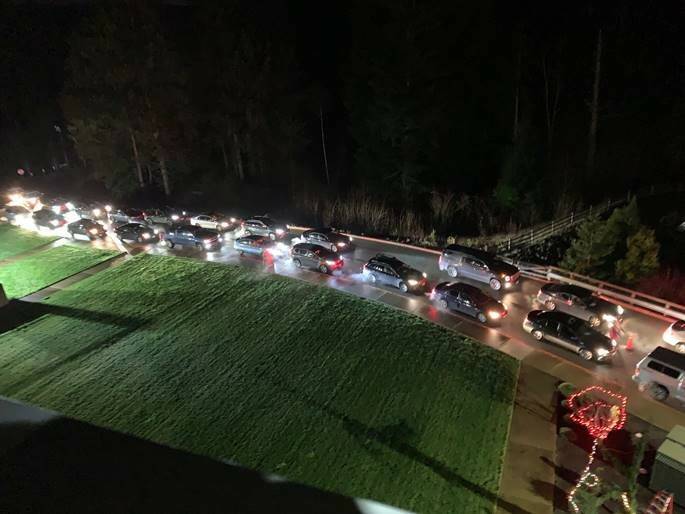The number of confirmed COVID-19 cases in the Snoqualmie/North Bend/Skykomish Health Reporting Area broke a single-day record on Dec. 24, as cases rose across the county over the holiday weekend.
The upper Snoqualmie Valley reported 40 confirmed cases Dec. 24, according to the King County dashboard. That is ten more than the previous record, set Dec, 31, 2020, when less than 1% of state residents had a dose of the vaccine.
Between Dec. 22 and Jan. 1, the upper Valley has broken or tied the 30 daily confirmed-cased mark four times. By comparison, the Valley only crested above 15 cases twice during the delta wave.
“The holidays have definitely put stress on COVID cases,” said Sherry Jennings, a spokesperson for the Snoqualmie Valley Hospital (SVH). “The omicron variant is so contagious and it’s really amongst us. All we can do is take those precautions to stay masked and socially distant.”
SVH’s testing site has expanded service since the omicron variant and continues to operate at full capacity, providing 140 tests and upwards of 160 vaccines daily.
Jason Rubin, a physician in charge of the SVH’s COVID team, said before last month, SVH’s testing site was down to three to five positive cases a day – that number has since risen to 18 cases. On Monday, Jan. 3, the hospital saw a spike, resulting in 38 positive cases.
“We anticipate that number will rise,” Rubin said.
King County as a whole also saw a single-day record of confirmed cases, reaching 4,764 on Dec. 29. That is a little less than four times greater than any other peak during the pandemic.
Although the rise in cases has not seen a corresponding rise in deaths, it has drastically increased hospitalization rates. Between Dec. 29, 2021 and Jan. 1, 2022, the county reported four consecutive days of daily hospitalizations near its single-day record. State health officials are worried this could overrun a hospital system that has continually been stretched thin.
According to King County data, the upper Valley has mostly avoided hospitalizations, seeing just three hospitalizations and no deaths between Dec. 17 and Dec. 30. However, that number could be an under count as residents who contract COVID-19 often go to hospitals outside of the Valley for treatment.
SVH generally does not treat COVID-19 patients. Jennings said the hospital instead takes on post-COVID patients to provide rehab and relieve bed space at larger hospitals. SVH has seen an increased need in COVID therapeutics.
Valley residents continue to be vaccinated at higher rates than the county as a whole, which is likely helping to keep them out of the hospital. Over the last month, unvaccinated King County residents were 30 times more likely to be hospitalized.
In King County 77% of people are fully vaccinated. That’s compared to 92% in Snoqualmie and 81% in North Bend. Fall City lags behind at 74%.
Additionally, 34% of King County residents have gotten a booster shot, compared to 41% of Snoqualmie residents, 35% of North Bend residents and 33% of Fall City residents.
Early data shows that the initial, two-dose vaccine series may be less effective against omicron, but it still offers protection against infection and severe illness, according to the state Department Of Health.
“Most of the positive patients I speak with are fully vaccinated and report a few days of mild cold or flu-like symptoms,” Rubin said. “Unvaccinated patients are much much more likely to report feeling very sick, with prolonged recovery times and occasional hospitalizations.”
Vaccination rates are, however, lower among school age children, who returned to school from winter break this week.
Although over 95% of Snoqualmie teens between the ages of 12 and 17 are fully vaccinated, both North Bend and Fall City remain below the 60% mark.
Rates for those between the ages of 5 and 11 are lower. Snoqualmie is on the high end at 43%, while North Bend and Fall City are at 30% and 24% respectively.
Still, it is unknown what effect schools could have on the current spike, rates of COVID among those 17 and under have been consistently under King County average rates since mid-December.
During the break, the district sent out reminders encouraging students to take precautionary measures and warning them about the spread of the omicron variant. Every school continues to have rapid testing available on site, district spokesperson Carolyn Malcolm said.
Before returning from break, more than 270 staff members opted to get tested. Also prior to break, the district also held eight vaccine clinics for students ages 5 to 11. Malcolm said although the district continues to offer online schooling as an option, it has no plans to revert all students to a hybrid or digital model, unless instructed by the DOH.
Rubin said it is important to remember that cold symptoms, such as a runny nose, congestion or minor sore throat, could be the first sign you have contracted COVID. If you are sick it is important to stay home and get tested.
Rubin also said to remember home tests are accurate for positives, but can provide false-negatives. Only a PCR test can give you a reliable negative.
Jennings said the hospital is working to provide extra availability for the pediatric and booster doses of the vaccine. On Dec. 16, the hospital provided over 250 vaccines and boosters at its Night of Lights Pediatrics event.
The hospital plans to host another drive-thru vaccine clinic , including boosters and pediatric vaccines, Saturday, Jan. 15. at the COVID Barn from 10 a.m. to 2.
“The demand is so high for pediatric doses and the booster doses that we’re just trying to do all that we can outside of our normal vaccine capacity to try to alleviate that pressure and make it available as much as possible,” Jennings said. “We’ve been trying to serve the valley as best we can.”
To schedule a vaccine appointment, visit: solvhealth.com/book-online/A4yalp.
This story has been updated to add additional information.


